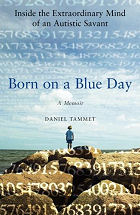Born on a Blue Day - summary review
By Murray Bourne, 15 Apr 2009
Born on a Blue Day — Inside the Extraordinary Mind of an Autistic Savant — A Memoir by Daniel Tammet (Free Press, 2006)
Summary Review

Daniel Tammet sees the number "1" as a very bright white, the number "11" is friendly, and "5" is loud like a clap of thunder. He has synesthesia, a condition that connects his senses together in a way that is as magical as it is rare.
According to Tammet, prime numbers (those that only have 2 factors, like 2, 3, 5, 7,...) are "smooth and pebble-like" while composite numbers (4, 6, 8, 9, ...) appear "jagged". My favorites — "39" is lumpy like custard and "89" reminds Tammet of falling snow.
There is much more to Tammet than his ability to see colors and shapes when he looks at numbers. He is an autistic savant. In particular, he was diagnosed with Asperger's Syndrome (or high functioning autism), which means he experiences many of the symptoms of autism but unlike most autistics, he is able to talk about his experiences.
Characteristics of autistic behavior include:
- Repetitive, obsessive actions
- Difficulties in social situations
- Lacking empathy (and awareness) of others
Autism affects men more than women (80% of autistics are male).
Mathematical abilities
Tammet can mentally calculate values like 374 (which equals 1,874,161) and 13/97 to 100 decimal places (0.13402061855670103092783505154639...). (I featured a video of this here: The Rain Man in each of us).
He once recited the first 22514 digits of pi. This is more of a memory feat rather than a mathematical one, but he was helped in this task by the fact that he could "see" the colors and shapes of the numbers.
The book opens with an account of his fascination regarding his birth date: 31 Jan 1979. Each of the following numbers drawn from the digits in this date are primes: 31, 19, 179 and 1979.
His life story
What makes Born on a Blue Day extraordinary is the fact that Tammet had a very difficult education. He was bullied by his classmates because of his "weirdness" and compulsive behavior. He was socially withdrawn and preferred his own company. For Tammet, secondary school was a nightmare after the relative orderliness of primary school. It must have been a very difficult for Tammet and for his teachers.
But Tammet still learned despite his difficulties. He would spend significant amounts of time in the school and public libraries. His continued passion for learning is evident in this book. He can write eloquently about his condition largely because he has conducted extensive background research.
He describes how his parents had to support a large family on a low salary. They believed in Daniel and supported him through the many difficulties he faced. Tammet gives this advice to parents of children suffering from epilepsy or autism:
Give your children the self-belief to hold on to their dreams, because they are the things that shape each person's future.
Amen to that - the above advice applies to all parents (and teachers).
Tammet suffered from epileptic fits as a child and he tells the story of the day he almost died during a dramatic rush to hospital.
Language Abilities
Apart from having extraordinary mathematical abilities, Tammet can learn languages extremely quickly (he once learned Icelandic in a week). His website, Optimnem sells foreign language courses.
Born on a Blue Day gives some sound advice on how to learn languages (no doubt as a teaser for his language courses).
Conclusion
Most of the book kept me enthralled. It was fabulous to dig into such an interesting mind.
Unfortunately, the narrative tended to get off track somewhere around the 3rd quarter of the book, but it was saved by a strong conclusion.
Overall, I strongly recommend this book for anyone who has an interest in the workings of the human mind. It gives great insights into learning, autism, savant syndrome and the traumas of someone who craves orderliness.
See the 4 Comments below.
